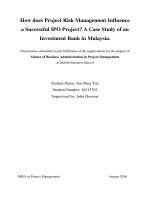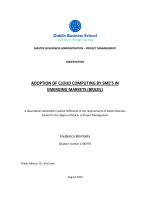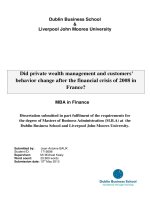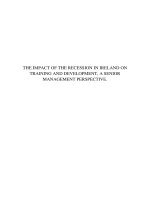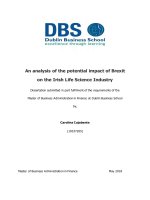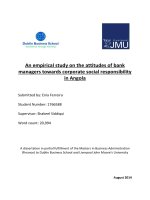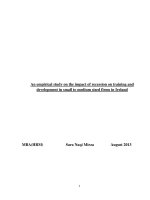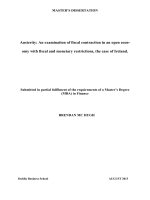Master Thesis in Economics: Impact of the sector on the accuracy of bankruptcy rates: The case of French food industries
Bạn đang xem bản rút gọn của tài liệu. Xem và tải ngay bản đầy đủ của tài liệu tại đây (1.23 MB, 99 trang )
MULLER Guillaume
MBA Finance
10120861
Impact of the sector on
the accuracy of
bankruptcy rates: the
case of French food
industries
Wordcount : 20051
Submission date : May 22, 2015
Table of Contents
Acknowledgements……………………………………………………………………………………………………….5
List of Illustrations ...................................................................................................... ….6
Abstract .......................................................................................................................... 8
Chapter 1 - Introduction ................................................................................................. 9
1.1 Background ........................................................................................................... 9
1.2 Research Area, Research Question, Research Objectives .................................. 10
1.3 Suitability of the Researcher ............................................................................... 11
1.3.1 Academic Background ................................................................................ 11
1.3.2 Work Background ........................................................................................ 11
1.4 Contributions of the Study .................................................................................. 12
1.5 Scope of the Research and Limitation ................................................................ 12
1.6 Recipients of the Research ................................................................................. 12
1.7 Dissertation Organization .................................................................................. 13
Chapter 2 - Literature Review ................................................................................... …14
2.1 Supplier risk assessment……………………………………………………………………………………….14
2.1.1 Risk and uncertainty for client companies……………………………………………..14
2.1.2 Supply Chain Risk Drivers and classification…………………………………………..16
2.1.3 Organisation of the client company : the process ………………………………….17
2.1.4 Supplier bankruptcy risk………………………………………………………………………..18
2.2 Bankruptcy prediction…………………………………………………………………………………………..19
2.2.1 Introduction…………………………………………………………………………………….…….19
2.2.2 Bankruptcy prediction through financial scores………………………………………20
2.3 Building a bankruptcy rate model…………………………………………………………………………22
2.3.1 Sector-specific information…………………………………………………………………….22
2.3.2 The model………………………………………………………………………………………………25
2
2.3.3 Online bankruptcy rate versus “Home-made” rate………………………………….26
2.4 Summary…………………………………………………………………………………………………………….…26
Chapter 3 - Research Methods .......................................................................................... 27
3.1 Introduction ....................................................................................................... 27
3.2 Research Philosophy ........................................................................................... 28
3.3 Research Approach ............................................................................................. 30
3.4 Research Strategy ............................................................................................... 31
3.5 Research Choice ................................................................................................. 31
3.6 Time Horizon ...................................................................................................... 32
3.7 Data Collection .................................................................................................... 33
3.7.1 Secondary Data Collection .......................................................................... 33
3.7.2 Primary Data Collection ............................................................................. 34
3.8 Population and Sample ....................................................................................... 34
3.8.1 Qualitative ................................................................................................... 34
3.8.2 Quantitative ................................................................................................ 34
3.9 Quantitative Data analysis ..................................................................................... 37
3.10 Ethical Issues ..................................................................................................... 39
3.11 Limitations of the Research .............................................................................. 40
Chapter 4- Data Analysis and Findings ......................................................................... 41
4.1 Structured Interviews…………………………………………………………………………………..41
4.1.1 Introduction………………………………………………………………………………………41
4.1.2 Observations…………………………………………………………………………………….41
4.2 Construction of a scoring model and impact of the “food-processing” sector…..51
4.2.1 Introduction…………………………………………………………………………………..….51
4.2.2 Principal component analysis…………………………………………………………….51
3
4.2.2.1 Introduction………………………………………………………………………..51
4.2.2.2 Data preparation and presentation……………………………………..51
4.2.3 Data analysis in SPSS………………………………………………………………………….52
4.2.4 Conclusion………………………………………………………………………………………….60
4.3.1 Introduction……………………………………………………………………………………….60
4.3.2 Data preparation and presentation…………………………………………………….61
4.3.3 Data analysis in SPSS………………………………………………………………………….62
4.3.4 Classification of the companies………………………………………………………….65
4.3.5 Validation of the model………………………………………………………………………67
4.4 Application of the z-score on the selected companies………………………………………72
4.5 Main findings…………………………………………………………………………………………………….78
Chapter 5 - Conclusions & Recommendations ............................................................. 80
5.1 Conclusion ........................................................................................................... 80
5.2 Recommendations............................................................................................ …82
Chapter 6 - Self Reflection on own learning and performance…………………………………………………..84
6.1 Reflection on learning……………………………………………………………………………………………84
6.1.1 Skills Development……………………………………………………………………………………...85
6.1.2 Research Capability and Analytical Skills……………………………………………………….85
6.1.3 Team building skill………………………………………………………………………….86
6.1.4 Communication and Language Skills…………………………………………………………..86
6.1.5 Finance Knowledge………………………………………………………………………….87
6.1.6 Time management………………………………………………………………………….87
6.1.7 Future application……………………………………………………………………………88
Reference………………………………………………………………………………………… ……………………..89
Appendix…………………………………………………………………………………………………………………93
4
Acknowledgements
The completion of this dissertation could not have been without the help of many people.
Firstly, I would like to thank my parents for always supporting me during my years of study.
Without you I wouldn’t be where I am today, and I certainly wouldn’t have the opportunity to
get this education and experience.
Secondly, I would like to thank my supervising professor, Mr. Justin O’Keefe. You helped
me make my dissertation clearer and were supporting me regularly. I thank you for your help
and for encouraging me.
Thirdly, I would like to thank my classmates and friends of MBA Finance, this year of study
was rich in meetings and exchanges and I met so many people from different countries which
helped me grow up.
I would like to thank the Dublin Business School for making this course available and for
having an exceptional faculty.
I would like to dedicate this dissertation to my family; my parents and siblings in France
I am so grateful to have had the opportunity to meet all the people mentioned above, and
without you this dissertation would not have been possible.
5
List of Illustrations
Figure 1A: Risk map (Deloach, 2000)
Figure 1B: Bankruptcy rate of manufacturing and food industries (Lilia Aleksanyany et al.)
Figure 2: Risk source in supply chain (Uta Jüttner, 2003)
Figure 3 : Altman’s Z-score classification (Source: D. Quagli, 2008, pp. 164)
Figure 4 : Research onion (Saunders, Lewis and Thornhill, 2007, p. 102)
Figure 5: "Deductive & Inductive Approach Theory" (Saunders et al., 2009, p. 126)
Figure 6: 15 selected financial ratios
Figure 7: List of selected failed and non-failed French food companies
Figure8: Number of suppliers
Figure9: issues with suppliers
Figure10: Results of bankruptcy
Figure11: Supply chain breakdown
Figure12: Financial health assessment
Figure13: Financial score as assessment tool
Figure14: Reasons of risk assessment lack
Figure15: risks in small and medium food-processing companies
Figure16: department of the company
Figure 17: Principal component analysis dataset (10 first lines)
Figure 18: Correlation matrix between financial ratios
Figure 19: SPSS KMO and Bartlett’s Test (SPSS screenshot)
Figure 20 : Communalities (SPSS screenshot)
Figure 21 : Total variance explained
Figure 22 : Rotated component Matrix
6
Figure 23: financial ratios selected
Figure 24: sample for the LDA (SPSS screenshot)
Figure 25: Tests of Equality of Group Means
Figure 26 : covariance equality test
Figure 27: Eigenvalues
Figure 28 : Wilk’s Lambda
Figure 29: Structure matrix
Figure 30 : Unstandardized coefficients
Figure 31: Functions at Group Centroids
Figure 32: score classification
Figure 33: Model validation table
Figure 34: Summary of the results for the LDA model
Figure 35: Summary of the results for the z-score model
Figure 36: Decision making process
Figure 37: "Stages of Learning" (Dale, 2001)
7
Abstract
Purpose - Through this Masters dissertation, the researcher aims to understand the use of
bankruptcy rates for the assessment of suppliers and the effect of sector-specific ratios on the
accuracy of bankruptcy rate.
Methodology - Through the literature review the researcher gained an enormous amount of
knowledge regarding the prediction of bankruptcy and general methods to construct
bankruptcy rates. Also, the researcher conducted a survey to which 24 respondents answered
questions regarding suppliers and bankruptcy rate.
Findings – Bankruptcy rate is an easy and quick to use tool that supply department of
companies could use in order to predict the failure of one or more of their suppliers. By
using specific ratio of the sector in which the company and its suppliers are operating, the
efficiency of the bankruptcy rate can be increased.
Limitations – The model constructed in this dissertation is limited to the food industry and
will not have the same results if applied on another sector.
Practical implications – The model developed in this dissertation can be directly used by
companies operating in the food industry as well as the method used to construct the model if
companies are willing to calculate their own bankruptcy rate.
Value of paper - This dissertation aims to add value to any companies operating in the food
industry and willing to predict the failure of its suppliers.
8
Chapter 1 - Introduction
1 . 1 Background
Supplier risk management is an evolving discipline in operations management for manufacturers;
organization is highly dependent on suppliers to achieve business objectives. Supplier risk management
is an essential discipline in order to avoid Supply-Chain breakdown due to suppliers’ bankruptcies.
Changing environments and trading processes have forced companies to change the way they are
assessing for the different risks related to their suppliers, the financial risk being the hardest to predict.
In order to assess this financial risk, bankruptcy rates are often used by companies as they represent a
quick evaluation of the risk, but they can be hard to build and can provide false results, especially when
the wrong variables are used. In order to reduce mistakes on the variables, some bankruptcy rate are
sector-specific while others are global, but does it mean that the first one is more accurate than the
second one?
One of the aims of the paper will be to understand how the sector can impact the efficiency and
accuracy of a bankruptcy rate.
The particular case of French companies in the food industry will provide a practical approach to the
paper in order to evaluate the level of importance of the sector to the efficiency of the bankruptcy rate
system.
Every year in France, more than 3,500 manufacturing companies go for bankruptcy, of which
nearly one third are declared in the food industries. Indeed, in 2013, many food-processing industries
became bankrupt. These bankruptcies had bad impact on the balance sheet of firms that had these
companies as suppliers. According to a French study, “companies in the food industry have trouble facing
raw material price volatility”, new companies in this sector are created every week and many of them go
bankrupt after only 1 year as they don’t have adapted strategies to manage raw material price volatility.
The main problem of a company that goes bankrupt is that it affects badly all companies it used to deal
with, especially when it was one of the main suppliers. An internal credit scoring remains a possible
solution that a company could undertake to avoid negative impacts in its balance sheet and cash flows. A
few years ago, internal scoring on suppliers wasn’t very common in a company as it was difficult to find
financial elements on the supplier, but since the repeated bankruptcies and the multiplication of
9
financial information databases of millions of companies on the internet, more and more firms are
starting to use scoring as prediction tool. There is thereby an increase in demand for automatic scoring
and scoring methods.
1.2 Research Area, Research Question, Research Objectives
The main objective of the paper will be to build an empirical application of credit risk modeling for
private held corporate firms in the food industry.
After having analyzed what are current bankruptcy predictionmethods, I will built a build two
different scoring models, one sector-spectific to the food industry and one global based on the z-score by
Altman in order to compare if any of them is more efficient.
The main problematic I’ll try to answer in my research is the following: Can the sector impact the quality
of assessment of a bankruptcy rate?
In addition to that, I will try to answer different related questions.
How is supplier risk managed ?
What are the benefits of using a scoring model?
Are online automatic scorings relevant?
Which financial element from financial statements are the most relevant in the case of food-processing
companies? As the relevance for a financial element depends partly of the sector in which the company
is, one of the aim will be to identify those financial ratios which are relevant for the food-processing
industry in order to build an accurate scoring model. Results obtained with the manual scoring model
will then be compared to online automatic scorings.
10
1.3 Suitability of the Researcher
The researcher holds high interest in this topic.. Academic background and work experience are
listed below to help justify the suitability of the researcher to this topic.
1.3.1 Academic Background
The researcher studied Finance 3 years in Strasbourg with a Corporate finance specialty and 1 years
in Paris (France) with a Controlling speciality. The researcher then studied finance at DBS from January
2014 to December 2014. While studying in Syrasbourg the researcher also developed a bankruptcy rate
model base on existing methods as part of an individual project.
1.3.2 Work Background
The researcher's working background in Finance is much more extensive than his academic
background in the field. The researcher began working in finance in 2009 as an accountancy internee in
a French car company and worked in the headquarters of the same company for 6 month the year after
in Germany. The researcher’s experience in the food industry began in 2010 as he started a 1 year
internship in a French company based in Strasbourg and operating in the food-processing industry. This
work experience made the researcher realize the many bankruptcies that occurred then and made him
wondering if there are solutions to avoid it.
11
1.4 Contributions of the Study
The researcher will provide an efficient bankruptcy rate model for French companies in the food
sector and will provide a better look on the advantages of using this kind of assessment tool.
The researcher will use his knowledge in finance and his past work experience to contribute as much
theory and practice to the research process as possible, with the hope that it will result in beneficial
results to the French food industry.
1.5 Scope of the Research and Limitation
The researcher will include statistical evidence and information in the literature review and also
draw upon the theories set forth by professional organizations and specialists in the food industry.
The primary limitation the researcher with deal with is the efficiency of the statistical method
used to construct the bankruptcy rate model, as there are many methods available, the researcher
will try to select the best one as well as the easiest one.
1.6 Recipients of the Research
Recipients of the research done for the purpose of this Masters dissertation for the Dublin Business
School are as follows:
-1st recipient: Dublin Business School
- 2nd recipient: Professor Justin O’keefe, the researcher's supervisor.
- 3rd recipient: the researcher himself (Guillaume MULLER), MBA Finance Candidate
12
1.7 Dissertation Organization
Chapter 1 will introduce the dissertation and will be comprised of several elements, including the area
being researched, research objectives, research question and researcher's background and more.
Chapter 2 includes the 'Literature Review' that resumes the entire secondary researcher to be
contributed to the final conclusion and recommendations.
Chapter 3 includes 'Research Methodology' and this section specifies how the researcher will
conduct his research project to meet his objectives.
Chapter 4 includes the 'Data Analysis and Findings' and this section will take an in depth look at
the research findings collected through the various research methods.
Chapter 5 includes both the 'Conclusion and Recommendations' and the researcher will
summarize important points from both the secondary and primary data collection to draw
conclusions and make recommendations regarding the research topic.
Chapter 6 will include the researcher's self-reflection throughout the process of this dissertation and
include insight on her overall experience at the Dublin Business School.
13
Chapter 2 - Literature Review
2.1 Supplier risk assessment
Even if companies are aware of supplier bankruptcy risks, only a few of them are equipped to handle
effectively against this kind of risk. French food industries are a good example as there is still a cost
killing approach inside purchase departments of these companies. Supplier bankruptcy risk management
and assessment became therefore a forgotten priority that is yet a key factor for business sustainability.
The following lines are aimed to understand the advantages of assessing its suppliers and how to
conduct an efficient supplier risk assessment trough the construction of a bankruptcy probability rate.
2.1.1 Risk and uncertainty for client companies
In a general approach, Deloach (2000) defines business risk as “the level of exposure to uncertainties
that the enterprise must understand and effectively manage as it executes its strategies to achieve its
business objectives and create value”. Another more standard definition defines risk as “the chance, in
quantitative terms, of a defined hazard occurring, it therefore combines a probabilistic measure of the
occurrence of the primary event(s) with a measure of the consequences of that/those event(s)”. (The
Royal Society, 1992, p. 4).
A quantitative definition of “Risk” could be expressed as follow:
Risk = Probability (of the event) x Business Impact (or severity) of the event
This is often illustrated in a risk map or matrix (Figure 1). While risks can be calculated, uncertainties are
genuinely unknown.
Figure 1A: Risk map (Deloach, 2000)
14
Risk within a supplier bankruptcy risk management context may be viewed in a similar manner, there can
be for example outcome uncertainty associated with whether a supplier is able to make product design
and specification changes in time (Bidault et al.,1998). Harland et al. (2003) define supply/supplier risk as
one of eleven risk types. In their paper they adopt Meulbrook’s (2000) definition of supply risk as
“adversely affects inward flow of any type of resource to enable operations to take place, also termed as
input risk”. When analyzing the literature on supply risk definitions, it seems that there are only a very
few relevant one. By analyzing the literature of supplier risk and existing supplier risk definitions in his
research, (Zsidisin, 2003) gives a new definition of what is supplier risk in today’s environment: “Supplier
risk is defined as the probability of an incident associated with inbound supply from individual supplier
failures or the supply market occurring, in which its outcomes result in the inability of the purchasing
firm to meet customer demand or cause threats to customer life and safety.” In addition, the scope for
understanding supplier bankruptcy risk differs according to industry (Pablo, 1999). According to that,
food-processing firms in France or in another country are more likely to understand supplier bankruptcy
risk in terms of threats to customer health.
With the help of this definition we understand that the lack of an efficient supplier bankruptcy risk
management system can directly affect customers of a company if one or more suppliers would go
bankrupt; there will be a break in the supply-chain which can in certain cases stop the whole production
chain. Many authors on the subject agree that supplier risk becomes a major issue for today’s companies
as it greatly increased since 2009-2010 (Lilia Aleksanyany et al., 2014) (Figure 1B), which placed a
financial strain on many suppliers and impeded their ability to meet contractual agreements; it is leading
to a situation of lowest cost but highest risk. (Barry 2004)
Figure 1B: Bankruptcy rate of manufacturing and food industries (Lilia Aleksanyany et al., 2014)
According to this chart, bankruptcies in the food industry are clearly multiplied by 2 between 2010 and
2012 while bankruptcies in the manufacturing sector decreased slightly.
15
2.1.2 Supply Chain Risk Drivers and classification
Uncertainty related to supplier bankruptcy risk becomes more and more important, according to
(Svensson, 2000) and (Christopher et al., 2002), the current global economic environment has shaped a
number of trends that increase the vulnerability to supplier risk, here are a few examples: reduction of
suppliers base, increase demand for on-time deliveries, globalization of supply chains. For (Barry, 2004)
risks related to suppliers bankruptcies were widening with “increased globalization, widening political
reach by leading countries, and the rise of market producing and consuming economies”. While for many
authors, it is more a matter of trend, C. Giunipero et al, 2010 explain supplier risk increased for the last
several years by strategies that have been taken by supply management and that emphasize cost
reduction and efficiency in the supply chain. These strategies include:
-
Reducing headcount
Reducing the number of suppliers
Reducing inventory levels
Increasing outsourcing
Using supply sources in low cost and developing countries
Reducing the number of suppliers is an important reason why so many French food companies
experienced big supply break down when one or more of their suppliers bankrupted (Lilia Aleksanyany et
al., 2014).
Matter of trend or strategies, it is obvious that competitive pressures are often the drivers of risk,
Svensson (2002) introduced the term “calculated risks” that a company takes in order to improve
competitiveness, reduce costs, and increase or maintain profitability.
Helen Peck(2006) in her report on business reliance in the food sector concluded that the drive for
efficiency and the just-in-time philosophy used by the food industry has progressively reduced stock
levels throughout the supply chain with the resulting damage to its resilience when an emergency
occurs.
The consolidation of distribution networks by food manufacturers and the trend towards using 3PL
(Third Party Logistics) providers, and reducing distribution sites means that the loss of a site due to
events such as a fire or flood could also cause a disruption in the supply chain. In the case of a
bankruptcy of one of its supplier, a just in time approach which result in almost a zero stock, can have a
very bad impact on the production chain of the company, the complete stop of the production chain
would be the worst case.
In addition to these economical factors, there are also specific factors to the French food industry system
that French professor Alain Courtois criticized. In addition to economical drivers explained above, there
are also issues regarding the nature of current food suppliers in France. According to Mr Courtois, French
16
raw material food suppliers which are located in the first stage of the supply chain were still too
traditional. Even if it was a successful business model 40 years ago, it seems now to deteriorate due to
the increase of liberalization and globalization. Traditional agriculture has to face new industrialized
agriculture like other industries have to face developed countries with low-cost labor. The increase of
international competitiveness coupled with a traditional agricultural system led to many bankruptcies of
companies located in the first stage of the supply chain.
In the literature, several ways of sources of risk classification coexist (e.g. Miller, 1992; Goldberg et al.,
1999). The classification helps to “clarify the relevant dimensions of potential disruptions faced by
organizations in supply chains and provides the basis for risk assessment” (Miller, 1992). (Uta Jüttner,
2003) classified supply-chain relevant risk sources into 3 categories: environmental risk sources,
network-related risk sources and organizational risk sources (Figure 2).
Figure 2: Risk source in supply chain (Uta Jüttner, 2003)
2.1.3 Organisation of the client company : the process
As expressed above, uncertainties create risks for the proper functioning of supply chains. The
implications for any organization faced with potential risks are huge.
Risk management is the making of decisions regarding risks and their subsequent implementation and
flows from risk estimation and risk evaluation (The Royal Society, 1992, p. 3). Zsidisin et al (2004) and
Zsidisin (2003) concluded that most companies recognize the importance of risk assessment programs
and use different methods, ranging from formal quantitative models to informal quantitative plans, to
assess supply chain risks.
17
Most companies invested little time or resources for reducing supplier bankruptcy risks. Repenning and
Sterman (2001), suggest that it is unusual for firms to invest in improvement programs in a proactive
manner as “nobody gets credit for fixing problems that never happened”. Bankruptcies in French food
industries were indeed uncommon before 2007 as it was a pretty stable sector; companies also had a
diversified supplier portfolio which allowed them to reduce the risk, it is not the case anymore
(Repenning and Sterman, 2001).
Sheffi (2001) goes a little further by saying that the two basic elements of resilience are redundancy and
flexibility. While some companies take a chance and hope that nothing bad will happen, some others
invest in building redundancy into the system and prepare a business continuity plan. By viewing this as a
strategic issue and becoming more flexible, these kinds of companies become resilient and can tackle
threats to supply chain disruption. Yet, if a risk never materializes, it becomes hard to justify the time
spent on risk assessments, contingency plans, and risk management (Zsidisin et al., 2000). This also leads
to evaluating the cost of loss due to an undesirable event occurring against the benefits realized from
having strategies in place that significantly reduce the chance of detrimental events with supply.
Like (Repenning and Sterman, 2001), (Sunil Chopra et al., 2004) go in the same way and say that most
companies develop plans to protect against recurrent and low-impact risks in their supply chains but
ignore high-impact, low-likelihood risks. For instance, a supplier with quality problems represents a
common, recurrent disruption. Without much effort, the customer can demand improvement or find a
substitute. In contrast, bankruptcies are more unusual, preparedness to prevent major disruption due to
supplier’s bankruptcies may be weak or uneven. Bankruptcies lead to long-term and serious disruption
which can hardly affect the client company.
The literature on bankruptcy as a cause of disruption is almost blank, as said before, there Is no reasons
to be interested in things that never happen, but the recent bankruptcies chain reactions in the French
food sector has proved the opposite, even risks with small chances to occurs have to be taken into
account, especially regarding damages that they can cause.
2.1.4 Supplier bankruptcy risk
As said above, there are several supply chain risks which have all financial implications. Everything that
happens within a supply chain eventually ends up in the income statement, balance sheet. Bankruptcy
risk defers from this kind of events as it embrace events where the primary and immediate effect is
financially related (Gregory L et al.., 2012), financial impact is the primary rather than subsequent effect.
Given that third-party data about suppliers is increasingly available it should come as no surprise that
most companies begin their supply chain risk management journey looking at financial risk of entities
within the supply chain. Assessing financial strength is necessary but is not a sufficient enough part of
bankruptcy risk management to be the only thing being assessed. We will be however focusing on this
kind of assessment in this paper as it is one of the best way to predict a bankruptcy. A variety of
18
approach exist for addressing bankruptcy risk across the supply chain. Many authors in the literature
advise Ratio analysis for supplier financial health assessment. (Gregory L et al., 2012 , E. Thanassoulis,
1996). According to (E. Thanassoulis, 1996), we use supplier financial ratios to manage risk by providing
insights that financial data alone cannot provide. When performed on a regular basis, ratio analysis can
help to highlight positive or negative trends trough the use of charts. In supply chain risk management,
ratio analysis is used to compare a supplier’s strength with another supplier operating in the same
industry. There are also various tool that use financial ratios to predict the potential of a supplier
bankruptcy. (L. Altman , 1998) introduced the Z-score as one of the most efficient Bankruptcy predictor,
this will be discussed below. In the context of supply chain risk management, (Gregory L et al.., 2012)
introduced 5 different situations where financial ratios can be used:
-
Evaluation of potential suppliers
A purchase requirement that involves a large amount of money
Purchasing items that are crucial for the conduct of the business
Entering into a longer term contractual agreement
Conducting regular risk scan of your supply chain
Even if ratio analysis seems easy in theory, one challenge is to obtain reliable data on a regular basis as
many companies use suppliers that are private companies and have therefore no obligations to make
available the same type of financial document as public companies (Chopra et al., 2004). As said before,
supply chains are becoming more globalized with more international suppliers within the different stages
of the supply chain, financial data in some countries may be less accurate and accessible.
2.2 Bankruptcy prediction
2.2.1 Introduction
Prediction of bankruptcy is one of the challenging tasks for every sort of organizations in
different industries in the world, it has been one of the most challenging tasks in accounting since the
1930’s and during the last 60 years an impressive body of theoretical and especially empirical research
concerning this topic has evolved (Zaygren, 1983 ; Altman, 1968). Back et al (1996) found in their studies
that two main approaches in bankruptcy prediction studies can be distinguished, the first and most often
used approach has been the empirical search for predictors (financial ratios) that lead to lowest
misclassification rates while the second approach is more concentrated on seeking for statistical
methods that would also lead to improvements in prediction accuracy.
Most failure prediction studies that were undertake before 1980 applied an empirical approach. They
aimed at improved prediction accuracy by appropriate selection of financial ratios for the analysis.
Naturally, these financial ratios have been selected according to their ability to increase prediction
accuracy. There are some efforts to create theoretical constructions in failure prediction context (Scott,
1981), but none unified theory has been generally accepted as a basis for the theoretical ratio selection.
The selection has been based on the empirical characteristic of the ratios. This has led to a research
19
tradition in which the effect of statistical method on predictor selection has been obvious. This paper will
be focused on an empirical approach only where efficient ratios will be selected trough a discriminatory
process and where the “bankruptcy probability rate” will be the mathematical linear function of all
selected weighted ratios.
2.2.2 Bankruptcy prediction through financial scores
The available literature about “bankruptcy scores” is mainly about studies on the evolution of
financial indicators for a certain number of companies, which have failed or not during the analyzed
period. The failure (or the success) of the management structure is being assessed by a particular
indicator known as “cutting score”, which is defined as a linear combination of a few main financial
indicators or financial ratios.
A bankruptcy probability rate or bankruptcy score represent a way of identify, quantify and control the
corporate risk of bankruptcy (B. Baesens et al., 2003). It can be represented as a financial diagnosis of the
company that leads to a relevant ranking, considering some financial indicators which are integrated in a
score function.
One of the most famous and well-established tools for predicting bankruptcy using ratios is the
Altman Z-score which combines a series of weighted ratios for both public and private firms. According
to his creator, Dr. Edward Altman, the Z-score is in average 85% accurate in predicting bankruptcy one
year in advance and 75% accurate in predicting bankruptcy two years in advance (Altman, 1968). In its
1968’s study, Altman signaled out four balance sheet and income statement variables, with an additional
stock market variable. The chosen variables regarded liquidity, profitability, leverage, solvency and
activity and were based on two distinct criteria: their popularity in literature and their potential
relevance for the study. Each company was given bankruptcy probability rate (Z-Score) composed by a
discriminant function of the 5 variables weighted by a coefficient. The study involved a group of 66
American manufacturing companies (33 healthy and 33 bankrupt), listed on the Stock Exchange and
showed that companies with a Z Score of less than 1.81 were highly risky and likely to go bankrupt;
companies with a score more than 2.99 were healthy and scores between 1.81 and 2.99 were in a grey
area with uncertain results). The results are shown in Figure 3.
Figure 3 : Altman’s Z-score classification (Source: D. Quagli, 2008, pp. 164)
20
The model was at the time extremely accurate since the percentage of correct predictions was about
95% and it received many positive reactions and only a few criticisms.
When we apply Altman’s Z-score on supplier bankruptcy risk, we notice that it has two attributes that
makes it an efficient scoring tool for risk managers. Firstly, it is a relative simple tool to construct as there
are only 4 ratios to be calculated for private firms and 5 ratios for public firms, the resulted score is also
easy to understand. Supply chain risk managers should calculate Z-scores at least quarterly (Altman,
1968).
Due to its popularity and its efficiency for predicting bankruptcy, I will be using Altman’s z-score as a
benchmark to assess the efficacy of the constructed sector-specific bankruptcy rate.
2.3 Building a bankruptcy rate model
In order to analyze if a bankruptcy probability rate or bankruptcy score that takes into account the sector
is more accurate than a global score (Altman’s z-score), a multivariate analysis will be firstly performed in
order to determine ratios that are specific to the food industry, I will then use a Linear discriminant
analysis in order to construct the score. The following lines analyze the literature about both techniques,
as well as bankruptcy prediction in general.
2.3.1 Sector-specific information
Performance of Sector-specific bankruptcy rate models
One of the aims of the paper will be to build a manual scoring model specific to the food industry by
using determinants of bankruptcy in this sector.
Previous studies on the subject led for example by Morning Star, an investment research firm, didn’t
take into account the sector of the company but still had good results with their scoring model. As this
paper will be focused on the food industry, I will use the specifics of this sector to build a more accurate
scoring model specific to food industries as the relevance for a financial element depends partly of the
sector in which the company is. A more accurate model will permit to reduce the number of prediction
errors. A previous research led by three Indian doctors in finance who published a study in the
International journal of innovation in 2011 about scoring models for the auto sector showed that by
taking into account the specificities of the auto sector, better results can be obtained.
21
Altman’s Z-score’s efficacy on companies operating in specific industries has been discussed for a
long time. A recent study led by F. Hussain et Al. in 2014 who analyzed the efficacy of the score in
predicting bankruptcy of textile companies in Pakistan showed that the score was only 81% accurate
which is even less than the 90% introduced before. The paper also showed that as the time horizon
increases accuracy rate of the Z score model decreases, accuracy rates given before were for a time
horizon of 1 year, the paper found for example that the accuracy rate for predicting bankruptcy 3 year in
advance was 62%. In our case, the resulted score will be compared with Altman’s z-score for a time
horizon of 1 year. Another criticism of Altman’s z-score is its age as it has been developed 46 years ago,
ratios that are found to be significant at a point in time may not show similar explanatory results when
used over another further period of time due to changes in the economic environment, market
conditions and government regulatory changes (Ben Chin-Fook Yap et Al., 2013)
Sector specific ratios
In order to compare the sector-specific bankruptcy score with a global bankruptcy score (z-score),
factors that are specific to bankruptcies but not specific to a sector will have to be determined. (Altman,
1968), for example found that the following ratios were particularly efficient when used in a scoring to
predict bankruptcy:
-
Working capital/Total assets
Retained Earnings/Total assets
Earnings before interest and taxes/Total assets
Market value equity/Book value of total debt
Sales/Total assets
(Beaver, 1966 ; Altman et al, 1968 ; Merton, 1974) used ratios for predicting possible company
failures and assessment of risk. Single ratios or a group of ratios are often used in both univariate and
multivariate studies. (Chen and Shimerda, 1981) found that there were 65 financial ratios that have been
used in 26 past studies. The study found that out of the 7 most popularly used ratios, three ratios
measure profitability and liquidity respectively while only one ratio measures solvency. (Hossariand
Rahman, 2005), identified 48 ratios used in 53 studies and found that out of the ten most commonly
used ratios, four measure profitability and liquidity respectively and two measure solvency.
It is however impractical and sometimes improbable to compute all the ratios to reach to a conclusion
desired for, it is therefore necessarily to identify a smaller set of ratios. It is not necessary to use so many
ratios as a smaller number of dominant ratios are sufficient to achieve a good level of accuracy (Taffler
RJ, 1983). With the presence of inter-relationships within and among the sets of financial ratios, a
smaller number of representative ratios may be sufficient to capture most of the desired information
(Hamdi and Abdelrazzak 1994)
22
The literatures usually distinguish two different tools when willing to simplify the structure of a
set of variables: the factor analysis and the principal component analysis. These both techniques are
typically used to analyze groups of correlated variables representing one or more common domains but
are different in the way they analyze data.
PCA was first formulated in statistics by (Pearson, 1901), who formulated the analysis as finding “lines
and planes of closest fit to systems of points in space”. It has been defined as “a statistical procedure
that uses an orthogonal transformation to convert a set of observations of possibly correlated variables
into a set of values of linearly uncorrelated variables called principal components”. The main idea of
principal component analysis is to reduce the dimensionality of a data set in which there are a large
number of interrelated variables, while retaining as much as possible of the variation present in the data
set”. The reduction will result in a new set of variables called the principal components which are not
correlated and where the first few components retain most of the variation that was present in all the
original variables (Jolliffe T., 2002). The most recent study on PCA applied on ratios selection was led by
Ben Chin-Fook Yap, Zulkifflee Mohamad and K-Rine Chong (2013), who investigates the application of
principal component analysis in the selection of financial ratios that are significant and representative for
different industry sectors. Companies in different industries, even in the same country, have different
operational, market and capital structures.
Factor analysis is defined as a “statistical tool that is used to analyze the relationships among a large
number of variables and to explain these variables in terms of their common underlying factors with
a minimum loss of information” (Hair et al., 2009). Factor Analysis was first applied to financial ratios by
(Pinches et al.,1973) in an attempt to develop an empirically-based classification of financial ratios. Since
then, researchers are using Factor Analysis as a mean of eliminating redundancy and reducing the
number of financial ratios needed for empirical research, research on the use of factor analysis with
financial ratios have developed in two main directions namely using factor analysis to test and develop
theoretical ratio structures and as another multivariate method to reduce the number of ratios used in
studies for predicting bond ratings, corporate failures, market crashes, and corporate acquisitions. Their
study used 42 financial ratios and after applying factor analysis, five factors were found to be significant
as they explain 72% of the ratio variances. (Tan et al., 1997) used the factor analysis on 29 financial ratios
in a Singapore study and found 8 underlying factors. They also applied factor analysis on 25 financial
ratios on Chinese construction companies and found 5 underlying factors. Factor analysis will be used in
our case to determine the underlying ratios relevant for food industry companies in France.
Recent studies on the research of specific variables for a specific area usually use the PCA model to
operate the dimension reduction (Ben Chin-Fook et al., 2013 ; Jianping Li et al., 2003 ; Helmy, 2009 ;
Sinescu et al., 2010). These studies as well as the statistical literature, recommend the use of the PCA
because of its advantage in quantifying the importance of each dimension for describing the variability of
a data set without much loss of information.
23
In regard of both techniques and their utility in the literature I can already state that the principal
component analysis would be more appropriate in my case as the objective is to obtain the minimum
number of factors, a maximum of 5 ratios, to explain a maximum proportion of the variance found in the
original variables.
2.3.2 The model
The scoring literature has grown extensively since Beaver (1966) and Altman (1968), who
proposed the use of Linear Discriminant Analysis to predict company bankruptcy. In the last decade,
there have been many moves both to expand and to unify the objectives of bankruptcy prediction
models. A great number of relevant models have been developed to improve prediction’s results. Within
this framework several methodologies have advanced, including linear discriminant analysis (Long, 1976;
Lee, 1985), logit models, probit models, multivariate regressions and logistic regression (Myers and
Forzy, 1963; Long, 1976; Wiginton, 1980). These last years, logit and probit models, have been the most
popular tools for building a bankruptcy scoring model. According to McDonald (1999), 178 articles in
accounting and finance journals between 1989 and 1996 used the logit model.
There are several studies comparing the results derived from different models (Wiginton, 1980; Charitou,
Neophytou and Charalambous, 2004; Chandy and Duett, 1990). Logit (or probit) is usually compared with
the Linear discriminant analsysis where the results obtained for both models are pretty equal, the LDA
being however easier to use. Even if the probit model seems to be especially relevant, Ohlson (1980) and
Platt (1990) presented some interesting studies using the Linear discrimiant analysis with the advantages
of being a pretty easy model to use. The most popular commercial application using this approach for
estimation is the Moody’s KMV Riskcalc developed for many coutrnies. The French model is presented by
Murphy et al. (2002). These past decades have seen the introduction of new methods like classification
trees and fuzzy algorithms. Some research using this kind of methods showed that good results can be
obtained (Tamaio, 2004 ; Caiazza, 2004). After careful consideration of the nature of the problem and of
the purpose of this paper I chose Linear Discriminant Analysis as the appropriate method as it easily
handles the case where the within-class frequencies are unequal and their performances has been
examined on randomly generated test data. Altman et al. (1981) discusses discriminant analysis in-depth
and reviews several financial application areas, LDA “tries to derive the linear combination of two or
more independent variables that will discriminate best between a priori defined groups”, which in our
case are failing and non-failing companies in the food industry.
In recent years, between 2006 and 2013, new studies have been undertaken on innovative scoring
models. Campbell, Hilscher, & Szilagyi (2008), for example, implemented a dynamic logit model to
predict corporate bankruptcies and failures at short and long horizons, using accounting and market
variables. They argued empirical advantages of the model over the bankruptcy risk scores proposed by
Altman (1968) and Ohlson (1980). Finally, they showed that stocks with a high risk of failure tend to
deliver anomalously low average returns. Even more recently, Altman, Fargher, & Kalotay (2011)
estimated the likelihood of default inferred from equity prices, using accounting-based measures, firm
characteristics and industry-level expectations of distress conditions. This approximately enables timely
24
modeling of distress risk in the absence of equity prices or sufficient historical records of default. Even if
all these models show great results in predicting a corporate failure, their implementation are very hard
to undertake. For time and simplicity reasons, I will use the Linear Discriminant Model which is famous
for the ease in its deployment. The purpose of the paper trying to analyse the impact of sector-specific
variables on the quality of the bankruptcy rate, it is these variables that will determine the efficiency and
not the model. Any model could therefore be used as it will not impact the results; I just choose the
easiest one.
2.3.3 Online bankruptcy rate versus “Home-made” rate
When considering a bankruptcy rate model for bankruptcy prediction, another question that
arises is why companies should build their own rate when there are plenty of automatic rates available
for free on the internet? According to Mazuir (2012), there are two main reasons for avoiding automatic
scores:
The purpose of a credit analysis is to understand the financial reality of a company, or an automatic
scoring is not going in that direction. The scoring comes out of the blue without allowing companies to
understand the whys and wherefores. “An automatic scoring can be compared to a sprinter who is so
much focused on the results that he forgets to run”.
A bankruptcy rate must be based on recent and quality information. An automatic rate brings no
guarantee in that.
Other researchers advice companies to take automatic scorings into account when analysing the credit
risk, it seems to be pertinent to automate scorings production regarding the number of suppliers to
analyse. In regard to this, Dun & Bradstreet database contains financial information about more than 200
millions companies around the world. A company that has many suppliers can be tempt by automatic
scorings in order to gain time and efficiency.
2.4 Summary
As noticed in this literature review it is almost necessary for current companies that conduct a supplier
bankruptcy risk management to use a bankruptcy probability rate in order to predict the bankruptcy of
their suppliers. Altman’s Z-score is therefore an efficient tool for risk managers but when applied on
specific sectors with smaller companies the rate of accuracy can decrease which can discourage risk
managers to use it as a tool. The efficacy of the Z-score depend of many variables which explains why it
can be extremely accurate in some cases like in the 1968’s study described above while less accurate in
other cases. The volatile nature of the Z-score makes it a good tool but not good enough for companies
whose supply chain management will be based on the z-score.
25
